 |
| Honoring True Freedom |
 |
| Honoring True Freedom |
On the Fourth of July, Americans will celebrate Independence Day at picnics, concerts, fireworks displays, and gatherings of many kinds, and they almost always sing. “America the Beautiful” will be popular, and so will “Our County, ’Tis of Thee” and of course the national anthem, “Star-Spangled Banner” (despite its notoriously unsingable tune). The words are so familiar that, really, no one pays attention to their meaning. But read them closely and be surprised how the lyrics describe the meaning of America in three very different ways.
The post The meanings behind the anthems of Fourth of July appeared first on OUPblog.
We can now say we’ve been at the Outer Banks during a hurricane. Hurricane Arthur blew through here last night. It was windy, rainy, and loud. Didn’t lose power; just the front porch screen. Actually, I hear the weather at home has been wicked too. Hope you’re enjoying some sunshine and warmth.
Here’s wishing our readers a happy, healthy, and safe Fourth of July!
Ever since 4 July 1777 when citizens of Philadelphia celebrated the first anniversary of American independence with a fireworks display, the “rockets’ red glare” has lent a military tinge to this national holiday. But the explosive aspect of the patriots’ resistance was the incendiary propaganda that they spread across the thirteen colonies.
Sam Adams understood the need for a lively barrage of public relations and spin. “We cannot make Events; Our Business is merely to improve them,” he said. Exaggeration was just one of the tricks in the rhetorical arsenal that rebel publicists used to “improve” events. Their satires, lampoons, and exposés amounted to a guerilla war—waged in print—against the Crown.
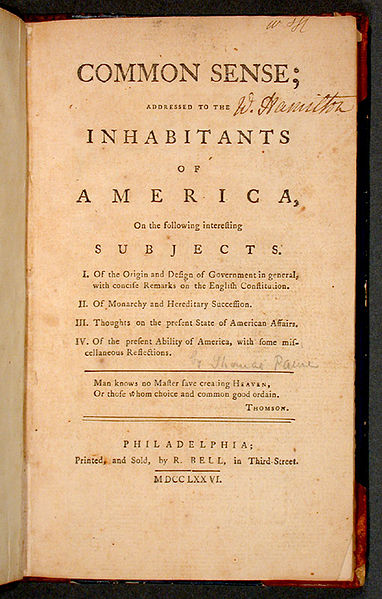
Cover of Common Sense, the pamphlet. Public domain via Wikimedia Commons.
In place of measured discourse and rational debate, the pyrotechnics of the moment suited “the American crisis”—to invoke the title of Tom Paine’s follow-up to Common Sense—that left little time for polite expression or logical proofs. Propaganda requires speed, not reflection.
Writing became a rushed job. Pamphlets such as Tom Paine’s had an intentionally short fuse. Common Sense says little that’s new about natural rights or government. But what was innovative was the popular rhetorical strategy Paine used to convey those ideas. “As well can the lover forgive the ravisher of his mistress, as the continent forgive the murders of Britain,” he wrote, playing upon the sensational language found in popular seduction novels of the day.
The tenor of patriotic discourse regularly ran toward ribald phrasing. When composing newspaper verses about King George, Freneau took particular delight in rhyming “despot” with “pisspot.” Hardly the lofty stuff associated with reason and powdered wigs, this language better evokes the juvenile humor of The Daily Show.
The skyrockets that will be “bursting in air” this Fourth of July are a vivid reminder of the rhetorical fireworks that galvanized support for the colonists’ bid for independence. The spread of political ideas, whether in a yellowing pamphlet or on Comedy Central, remains a vital part of our national heritage.
Russ Castronovo teaches English and American Studies at the University of Wisconsin-Madison. His most recent book is Propaganda 1776: Secrets, Leaks, and Revolutionary Communications.
Subscribe to the OUPblog via email or RSS.
Subscribe to only language articles on the OUPblog via email or RSS.
The post Rhetorical fireworks for the Fourth of July appeared first on OUPblog.
The Fourth of July is a special day for Americans, even for our presidents. Three presidents — John Adams, Thomas Jefferson, James Monroe — died on the Fourth of July, but only one — Calvin Coolidge — was born on that day (in 1872). Interestingly, Coolidge was perhaps the least likely of any of these to have attained the nation’s highest elective office. He was painfully shy, and he preferred books to people. Nonetheless, he successfully pursued a life in politics, becoming Governor of Massachusetts followed by two years as Warren Harding’s Vice-President. When Harding died of a heart attack, Coolidge became an unlikely president. Perhaps even more unlikely, he became not only an enormously popular one, but also the one whom Ronald Reagan claimed as a model.

Helen Keller with Calvin Coolidge, 1926. National Photo Company Collection. Public domain via Library of Congress.
Over the course of his presidency, Coolidge either took or approved several initiatives, which have endured and changed the nature of the federal government. He was the first president to authorize federal regulation of aviation and broadcasting. He also signed into law the largest disaster relief authorized by the federal government until Hurricane Katrina. Moreover, he supported the creation of both the World Court and a pact, which sought (ultimately in vain) to outlaw war. Along the way, he became infamous for a razor-sharp sense of humor and peculiar commitment to saying as little as possible (in spite of his constant interaction with the press) and advocating as little regulation of business as possible. His administration became synonymous with the notion that the government that governs best governs least.
Coolidge, nonetheless, has become largely forgotten, partly because of his own choices and partly because of circumstances beyond his control. Just before his reelection, his beloved son died from blood poisoning originating from a blister on his foot. Coolidge never recovered and the presidency lost its luster. By 1928, he had no interest in running again for the presidency or in helping his Secretary of Commerce Herbert Hoover succeed him in office.
Despite the successes he had in office, including his popularity, Coolidge paid little attention to racial problems and growing poverty during era. When the Great Depression hit, the nation and particularly the next president, Franklin D. Roosevelt, construed it as a reflection of the failed policies and foresight of both Hoover and his predecessor. Despondent over his son’s death, Coolidge did little to protect his legacy and respond to critics throughout the remainder of Hoover’s term. When he died shortly before Franklin Roosevelt’s inauguration, he was largely dismissed or forgotten as a president whose time had come and gone. Nevertheless, on this Fourth of July, do not forget that when conservative leaders deride the growth of the federal government and proclaim the need for less regulation, they harken back not only to President Reagan but also to the man whom Reagan regarded as the model of a conservative leader. Calvin Coolidge’s birthday is as good a time as any to remember that his ideals are alive and well in America.
Michael Gerhardt is Samuel Ashe Distinguished Professor of Constitutional Law at the University of North Carolina, Chapel Hill. A nationally recognized authority on constitutional conflicts, he has testified in several Supreme Court confirmation hearings, and has published five books, including The Forgotten Presidents and The Power of Precedent. Read his previous blog posts on the American presidents.
Subscribe to the OUPblog via email or RSS.
Subscribe to only American history articles on the OUPblog via email or RSS.
The post Calvin Coolidge, unlikely US President appeared first on OUPblog.
There’s not much history in our holidays these days. For most Americans, they’re vehicles of leisure more than remembrance. Labor Day means barbecues; Washington’s Birthday (lumped together with Lincoln’s) is observed as a presidential Day of Shopping. The origins of Memorial Day in Confederate grave decoration or Veterans Day in the First World War are far less relevant than the prospect of a day off from work or school.
Independence Day fares a little better. Most Americans understand it marks the birth of their national identity, and it’s significant enough not to be moved around to the first weekend of July (though we’re happy enough, as is the case this year, when it conveniently forms the basis of a three-day weekend). There are flags and fireworks abundantly in evidence. That said, the American Revolution is relatively remote to 21st century citizens, few of whom share ancestral ties, much less sympathy, for the views of the partisans of 1776, some of whom were avowedly pro-slavery and all of them what we would regard as woefully patriarchal.
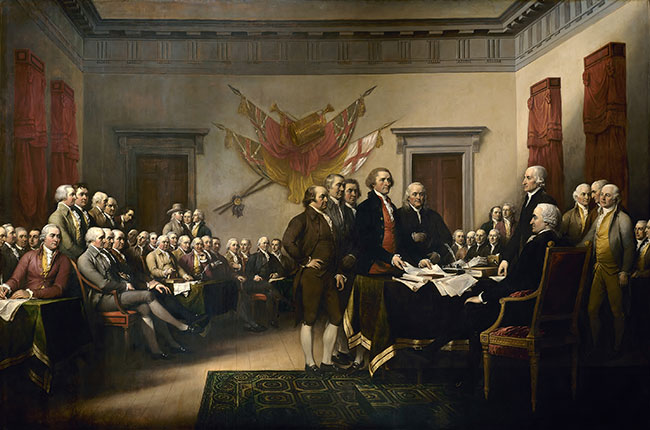
The Declaration of Independence by John Trumbull. Public Domain via Wikimedia Commons.
The main reason why Independence Day matters to us is that it commemorates the debut of the Declaration of Independence in American life (the document was actually approved by Congress on July 2nd; it was announced to the public two days later). Far more than any other document in American history, including the Constitution, the Declaration resonates in everyday American life. We can all cite its famous affirmation of “life, liberty, and the pursuit of happiness” because in it we sense our true birthright, the DNA to which we all relate. The Declaration gave birth to the American Dream — or perhaps I should say an American Dream. Dreams have never been the exclusive property of any individual or group of people. But never had a place been explicitly constituted to legitimate human aspiration in a new and living way. Dreams did not necessarily come true in the United States, and there were all kinds of politically imposed barriers to their realization alongside those that defied human prediction or understanding. But such has been the force of the idea that US history has been widely understood — in my experience as a high school teacher working with adolescents, instinctively so — as a progressive evolution in which barriers are removed for ever-widening concentric circles that bring new classes of citizens — slaves, women, immigrants, gays — into the fold.
This is, in 2014, our mythic history. (I use the word “myth” in the anthropological sense, as a widely held belief whose empirical reality cannot be definitively proved or denied.) But myths are not static things; they wax and wane and morph over the course of their finite lives. As with religious faith, the paradox of myths is that they’re only fully alive in the face of doubt: there’s no need to honor the prosaic fact or challenge the evident falsity. Ambiguity is the source of a myth’s power.
Here in the early 21st century, the American Dream is in a season of uncertainty. The myth does not assert that all dreams do come true, only that all dreams can come true, and for most of us the essence of can resides in a notion of equality of opportunity. We’ve never insisted on equality of condition (indeed, relatively few Americans ever had much desire for it, in stark contrast to other peoples in the age of Marx). Differential outcomes are more than fine as long as we believe it’s possible anyone can end up on top. But the conventional wisdom of our moment, from the columns of Paul Krugman to the pages of Thomas Piketty, suggests that the game is hopelessly rigged. In particular, race and class privilege seem to give insuperable advantage over those seeking to achieve upward mobility. The history of the world is full of Ciceros and Genghis Khans and Joans of Arc who improbably overcame great odds. But in the United States, such people aren’t supposed to be exceptional. They’re supposed to be almost typical.
One of the more curious aspects of our current crisis in equality of opportunity is that it isn’t unique in American history. As those pressing the point frequently observe, inequality is greater now than any time since the 1920s, and before that the late nineteenth century. Or, before that, the antebellum era: for slaves, the difference between freedom and any form of equality — now so seemingly cavernous, even antithetical — were understandably hard to discern. And yet the doubts about the legitimacy of the American Dream, always present, did not seem quite as prominent in those earlier periods as they do now. Frederick Douglass, Horatio Alger, Emma Lazarus: these were soaring voices of hope during earlier eras of inequality. F. Scott Fitzgerald’s Jay Gatsby was a cautionary tale, for sure, but the greatness of his finite accomplishments was not denied even by normally skeptical Nick Carraway. What’s different now may not be our conditions so much as our expectations. Like everything else, they have a price.
I don’t want to brush away serious concerns: it may well be that on 4 July 2014 an American Dream is dying, that we’re on a downward arc different than that of a rising power. But it is perhaps symptomatic of our condition — a condition in which economic realities are considered the only ones that matter — whereby the Dream is so closely associated with notions of wealth. We all know about the Dreams of Andrew Carnegie, Henry Ford, Bill Gates, and Mark Zuckerberg. But the American Dream was never solely, or even primarily, about money — even for Benjamin Franklin, whose cheeky subversive spirit lurks beneath his adoption as the patron saint of American capitalism. Anne Bradstreet, Thomas Jefferson, Martin Luther King: some of these people were richer than others, and all had their flaws. But none of them thought of their aspirations primarily in terms of how wealthy they became, or measured success in terms of personal gain. Their American Dreams were about their hopes for their country as a better place. If we can reconnect our aspirations to their faith, perhaps our holidays can become more active vessels of thanksgiving.
Jim Cullen is chair of the History Department of the Ethical Culture Fieldston School in New York. He is the author of The American Dream: A Short History of an Idea that Shaped a Nation and Sensing the Past: Hollywood Stars and Historical Visions, among other books. He is currently writing a cultural history of the United States since 1945.
Subscribe to the OUPblog via email or RSS.
Subscribe to only American history articles on the OUPblog via email or RSS.
The post July 4th and the American Dream in a season of uncertainty appeared first on OUPblog.
Hubby, Oso and I went to a great BBQ potluck on the 4th. We love the mountains and hubby’s family has been going up there for generations. So, there were a lot of new and old friends at the BBQ. Not only did we celebrate the country’s birthday, but a few actual birthdays too ![]() Anyway, during most of the party there was this girl in purple pants sitting far away from everyone on her rock. She went and got her food (oh, man was there some AMAZING food!) and went back on her rock to eat by herself. When her brother came and sat beside her, she didn’t really get mad, but she didn’t want anyone to sit with her on her rock either
Anyway, during most of the party there was this girl in purple pants sitting far away from everyone on her rock. She went and got her food (oh, man was there some AMAZING food!) and went back on her rock to eat by herself. When her brother came and sat beside her, she didn’t really get mad, but she didn’t want anyone to sit with her on her rock either ![]()
Hope you had a wonderful 4th of July. Any good potluck recipes you shared/ate this weekend? Here’s the recipe for the salad I brought, it’s one of my favorites ![]()
As you know, I've been a blog-slacker lately. Who knew that having four kids and a big house would be so time-consuming? Anyway, publishers have been asking me to review various titles, and I've been passing most of them by. Sad, but true.

Puppicasso found his red,
white and blue.
Then he got efficient and found all three in an unlikely source…
He had a safe and sane holiday, protected from the fireworks. It is such a tough holiday for dogs in general, I am happy he survived through another one.
 Today in History, from the Library of Congress American Memory, we celebrate the Fourth of July. PBS.org offers a comprehensive history of Independence Day at A Capitol Fourth, America’s Independence Day Celebration including the history and music of the celebration, the history of Old Glory and the National Mall, and lots of links to significant people, places, monuments, and museums of our shared American history. Check it out. Here is a link to local San Francisco Bay Area Fourth of July Events.
Today in History, from the Library of Congress American Memory, we celebrate the Fourth of July. PBS.org offers a comprehensive history of Independence Day at A Capitol Fourth, America’s Independence Day Celebration including the history and music of the celebration, the history of Old Glory and the National Mall, and lots of links to significant people, places, monuments, and museums of our shared American history. Check it out. Here is a link to local San Francisco Bay Area Fourth of July Events.
Speaking of local, did you know the annual Outside Lands Music and Arts Festival held in San Francisco’s Golden Gate Park in August brings more than $67 million to the local economy, including over 750 jobs. See San Francisco State University Professor Patrick Tierney’s study. Tierney is chair of the Department of Recreation, Parks and Tourism at SFSU.
And. . . a music-based curriculum, Academic Music, designed by SFSU researchers Susan Courey and Endre Balogh, is helping children understand fractions. See the findings of the six-week trial run at Palo Alto’s Hoover Elementary School in the journal Educational Studies in Mathematics. Look out Kahn Academy! Both of these SFSU studies were highlighted in the SF State Magazine Spring/Summer 2012 edition.
Finally, artist and SFSU Alum Steven J. Backman used 30,000 toothpicks in his 13-foot long replica of the Golden Gate Bridge. Now on display at the Ripley’s Believe It or Not! Museum at Fisherman’s Wharf in San Francisco.
Graphic courtesy Flickr Creative Commons License by Citoyendu Monde Inc.
Related articles
The Fourth of July is a big event in a former hometown of mine, Seward Alaska. Every year, the little town of approx 3000 expands to approx. 30,000 to celebrate this holiday. The main reason for this is the annual running of one of America’s oldest footraces, The Mount Marathon Race®.
Runners from all over the world participate in the running up and down of the 3022 foot mountain. As a former racer, I can tell you that it is one of the most exhilarating things I have experienced in my life.
Here is a map I did of Seward for They Draw & Travel:
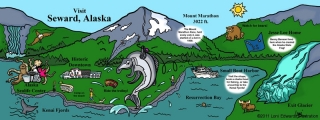
Good luck to my sister, brother-in-law, twin nieces, and friends as the race this year! Be safe and have a happy 4th!
*Note* for those that would like to view the race via livestream check out Ktuu.com’s site for full coverage of the race which starts at 930 am Alaska time, July 4th. To learn more about the Mount Marathon race, visit the Seward.com website.
Where’s your favorite beach?
A thank you vlog, in a stolen moment.

What are you doing this Fourth of July weekend? Anything fun?
K and I saw fireworks from where we think was Central Park last night. It's our second week staying on the Upper East Side (like, 3 blocks from Bloomys) and we're going back to Brooklyn this weekend to get mail, see the kitties, etc. I still haven't gotten used to having an elevator man or being up so high (21st floor), but I do love the view and spending time with Gram has been great.
I got up early to write and want to keep going, but share your weekend plans!
xo
Some Fourth of July’s are more memorable than others. And as it’s harder and harder for us to even find a fireworks display in these lean years, I appreciate more and more the ones with truly great fireworks shows. But there’s always something more than the great fire in the sky that makes those nights memorable. Always something unexpected that happened. And it was on one such Fourth of July that I set out with my newborn daughter for the very first time after we came home from the hospital, along with my entire family.
We all piled into the car with lawn chairs and diapers and drove down our newly poured driveway, technically permitted as a sidewalk it was so steep. The technological marvel enabled me to make the trip out as we had one hundred steps to our front door and which, pre-driveway and after my first C-Section, landed me in the house for two solid months before I was physically up to the daily challenge of the descent and ascent.
So the freedom of the drive was excitement enough. But it was the venue too that made the evening even that much sweeter. We drove to my school, The Art Center College of Design, in the foothills surrounding The Rose Bowl. There was a small group of teachers and students gathered there in what used to be a sculpture park and is now the General Motors Computer Lab. We set out our chairs and I had one daughter running around the sculptures and the other in my arms. And I’ll never forget Joe, the shop guy, melting at the sight of my baby. He was a task master at school. The one who eyed the craftsmanship of the models we would create of the products we designed in the Industrial Design program, but a big softie in front of babies. I’d never seen him smile like that.
I’d left school to have another baby because that was the most important thing to me. And everyone at school was so supportive. In the twilight I caught up with my friends on how life was in their fifth term and how mine was in the early days of being a mother of two. Then the show began. One after another the rockets flared and the music played and it was pure magic sitting there, watching fireworks shoot from the Rose Bowl and explode at our level in the foothills. My mom was there too which was an extra special treat, since she’d come all the way from Chicago to help with the baby.
And with my baby in my arms and in the rockets red glare, sitting next to my former classmates and around a few of my teachers so many emotions exploded inside of me. Yes, this wasn’t the typical way a woman goes through college, but it was my way. And it felt so right.

It’s the Fourth of July, the day when the United States celebrates its independence from Britain. When I lived in America as a child, I remember watching a brilliant Fourth of July parade in a town called Cody, Wyoming, home of Buffalo Bill no less.
Nowadays, I can’t hear the words “Independence Day” without thinking of the epic movie, with mankind defeating alien invaders against all the odds. Some of the film is superbly written, including President Bill Pullman’s rousing speech outside Area 51 to his ragtag bunch of fighter pilots, tasked with bringing down an alien mother ship.
“In less than an hour, aircraft from here will join will join with others from around the world and you will be launching the largest aerial battle in the history of mankind. ‘Mankind’ … that word should have new meaning for all of us today. We can’t be consumed by our petty differences anymore … Perhaps it’s fate tat today is the Fourth of July, and you will once again be fighting for our freedom – not from tyranny, oppression or persecution, but from annihilation. We’re fighting for our right to live – to exist. And should we win the day, the Fourth of July will no longer be known as an American hooliday, but as the day when the world declared in one voice:
“We will not go quietly into the night.
“We will not vanish without a fight.
“We’re going to live on.
“We’re going to survive.
“Today, we celebrate our Independence Day!”
Just thinking about that scene brings a tear to my eye, and it’s especially relevant at the moment as I write the third Johnny Mackintosh book, provisionally entitled Johnny Mackintosh: Battle for Earth. And I know that any great rallying speeches had better hit the spot, just in case Hollywood comes calling for the movie rights.
Happy Fourth of July to all my American friends!
 Add a Comment
Add a Comment
It’s time for stars, stripes, fireworks and the celebration of our nation’s independence! So while you are waiting for the fireworks to start, or the hot dogs to grill, celebrate the 4th of July by opening the pages of some of these amazing books!
John, Paul, George & Ben
By Lane Smith
Go back in time wi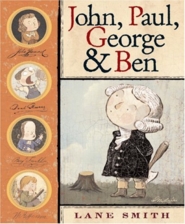 th John Hancock, Paul Revere, George Washington and Benjamin Franklin! Written on parchment-like paper with pen-and-ink cartoon illustrations, Smith tells the individual stories of our Founding Fathers in humorous and exaggerated way. From Paul Revere screaming “The red coats are coming!” to John Hancock’s giant signature on the Declaration of Independence, children and adults are sure to fall back in time to the birth of our nation!
th John Hancock, Paul Revere, George Washington and Benjamin Franklin! Written on parchment-like paper with pen-and-ink cartoon illustrations, Smith tells the individual stories of our Founding Fathers in humorous and exaggerated way. From Paul Revere screaming “The red coats are coming!” to John Hancock’s giant signature on the Declaration of Independence, children and adults are sure to fall back in time to the birth of our nation!
Yankee Doodle and the Red Coats: Soldiering in the Revolutionary War
By Susan Provost Beller
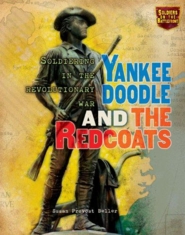 Perfect for any young history buff, Yankee Doodle and the Red Coats tells the story of the Revolutionary War through soldiers’ real life accounts of their experiences. From diaries, letters to loved ones and accounts of battles, the food, and life during the war, Beller’s book gives an exclusive look at what it was really like to fight for our nation’s independence!
Perfect for any young history buff, Yankee Doodle and the Red Coats tells the story of the Revolutionary War through soldiers’ real life accounts of their experiences. From diaries, letters to loved ones and accounts of battles, the food, and life during the war, Beller’s book gives an exclusive look at what it was really like to fight for our nation’s independence!
Young Founders: 1776: Son of Liberty: A Novel of the American Revolution
By Elizabeth Massie
Told throu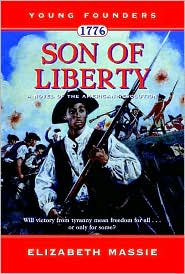 gh the voice sixteen-year old Caleb, a free black living in a slave state, Young Founders: 1776, provides an interesting perspective of life during the Revolutionary War. When British Governor, Lord Dunmore promises that all slaves who join his army will remain free, Caleb is faced with a difficult choice: he can join Washington’s army and fight for America’s independence, or join Dunmore’s army and be free forever. Massie’s book is perfect for any young adult who wants an inside view on the fight for freedom!
gh the voice sixteen-year old Caleb, a free black living in a slave state, Young Founders: 1776, provides an interesting perspective of life during the Revolutionary War. When British Governor, Lord Dunmore promises that all slaves who join his army will remain free, Caleb is faced with a difficult choice: he can join Washington’s army and fight for America’s independence, or join Dunmore’s army and be free forever. Massie’s book is perfect for any young adult who wants an inside view on the fight for freedom!
So this 4th of July, kick back, relax and enjoy these great books that celebrate the birth of our nation!
I know I've posted a few times about our fabulous 4th of July weekend. Bear with me one more time, because I want to post my picture favs for C Jane's Photo Contest. 



Holidays in very small towns are, well, just plain fun. What can I say. You know almost everyone. You know what they are going to put in the parade. You know who will be cooking what, and you know where to find the best whats. Mountainair's Fourth of July is one of our biggest celebrations, probably because we have four true seasons here in the Rocky Mountains, and July is just about our best month to let it all hang out and throw a party for the whole town. Yesterday was typical for our Jubilee. It began with a parade which includes horses, dogs, classic cars and trucks, our fire engines, ambulance, our US forestry service, a cannon which gets fired from the back of a truck, our police, our businesses, often our county sheriff has representatives, sometimes even our big state politicos show up. This year a favorite was our animal control officer, who crawled inside her dog catcher's cage and was hauled down Broadway. She is a good person, and she is working well beyond her paid hours to get donations to help build a real shelter for homeless animals. Mountainair has lots of homeless animals, but no proper place to put them.
Anyway, it was a good parade. At the end, candy gets tossed at the little children. I've been known to turn into one of those little children, and have eaten some of that candy. Afterwards, we have a genuine old fashioned carnival with rides, a ferris wheel, cotton candy, balloons, and carnival games. We have a rodeo, vendors, live music, and book signings. I was the book signer this year because my sixth book just showed up a few weeks ago.
Book signings in a small town are also a lot of fun. You set up your table under a fancy little shade canopy as close to the sidewalks and live music as possible. You add a few extra chairs, some water, and you wait. In a hurry your friends see you, they join you, sit in the extra chairs, and the catching up, laughter and comraderie is priceless. I enjoy the social aspect more every year, probably because each year I've lost at least one friend or family member, and that makes me cherish everyone so much. Also, there are always a lot of new people who've driven in from other places. I delight in meeting them, especially when they take time to linger and tell me something about themselves.
Finishing everything off in the evening is the fireworks display. Mountainair depends on donations, and our fireworks are magnificent, but don't last quite as long as we'd like. This year, a neighbor who lives a few miles away, must have found a truck load of the best fireworks. His display began before the Town's, was more elaborate, louder, and lasted longer. Wow. Too cool! All in all, what a good day to be an American, small town, or wherever. Just a good day.
 Sit by a breeze, if you can.
Sit by a breeze, if you can.
Live the day.
 Was July 1 really America's Independence Day? Peter de Bolla, writing in The Fourth of July, offers a very different version of America's actual birthday:
Was July 1 really America's Independence Day? Peter de Bolla, writing in The Fourth of July, offers a very different version of America's actual birthday:
Excellent site you’ve got here.. It’s difficult to find excellent writing like
yours nowadays. I seriously appreciate individuals like
you! Take care!!